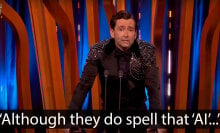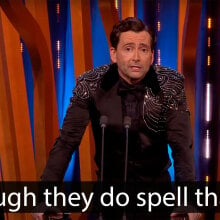The last 12 months have been a whirlwind of both technological advancements and unwelcome changes, from the continued hype around artificial intelligence to the ups and downs of social media giants.
Similarly, within the push for greater digital accessibility and improvements in assistive technology, 2023 has ushered in immense successes and unfortunate failures among the industry's leading forces and pioneers — a clash of creativity and profit alongside a wider cultural conversation on the need for increased support and visibility for the disability community.
Still, the year's fair share of wins are making meaningful changes in people's lives, from increased customizability of the online experience to accessibility shifts in the world of live entertainment, and they're also proving that sometimes a simple addition is all that's needed to make a digital environment significantly more accessible.
Mashable's rounded up a few of tech's accessibility standouts this year.
GIPHY adds alt text.
In 2023, popular GIF platform GIPHY partnered with digital accessibility provider Scribely to provide alt text captions for its most popular content, making the video-and-meme-based language of the internet more accessible to users who are blind.
Tweet may have been deleted
Announced in late December 2022, the alt text additions were intentionally human-written, circumnavigating problems many other sites have faced with auto-generated alt text, and improving the ability of screen readers to accurately describe visual media and read webpages or social feeds for users. Starting with 15 writers working on the first 1,000 GIFs, the team at Scribely began rolling out about 3,500 descriptions per week to chip away at "the ever-expanding GIF ocean," Scribely representatives shared in a summary of a presentation for the AccessU 2023 accessibility conference.
"GIFs are an important part of our daily lives, thanks to their unique ability to convey ideas, emotions, and humor in ways that static images often can't. These looping videos move us to moments of joy and happiness. But without alt text, the moment is lost and excludes millions," said Caroline Desrosiers, founder and CEO of Scribely. "That's why this project with GIPHY is so monumental and necessary."
Netflix launches custom subtitles and paves the way in audio description.
In a win for universal captioning advocates, Netflix stepped up its subtitle and captioning game by introducing customizable options for its accessibility text feature. Announced in March, the streaming service now lets users change font size and style, as well as the color and appearance of on-screen captions. As reported by the Verge, the captions include three new text style options with contrasting backgrounds to make the text stand out: Light (black text and white background), Drop Shadow (white text and black background), and Contrast (yellow text and black background).
Customizable text, not just text zooming, is considered a main component of web accessibility, allowing all users to adapt websites to their needs.
Netflix also continued paving the way in accessibility options for those who are blind or have low vision, winning major awards in audio description at this year's American Council for the Blind's awards gala. The streaming service also released its new limited series All the Light We Cannot See, which featured "rule-breaking" descriptive narration and highlighted cast and crew with disabilities.
Gaming gets in on expanded gameplay for users with disabilities.
Early in the year, at the annual CES tech convention, Sony unveiled it was designing a new adaptive game controller, known as Project Leonardo, for PlayStation 5. The controller allows a user to customize its use and design features, as well as attach third-party accessibility accessories, to help players with limited motor control.
In April, the company also announced it was making its PlayStation experience easier to navigate for users with disabilities by including obvious accessibility tags to all of its offered games. The tags include notes on relevant visual, audio, control, and gameplay features for each game.
In May, Xbox announced new features for the Xbox App on PC, such as the ability to reduce visual elements on screen, and introduced a new tagging and search feature to support users looking for accessible games.
Other popular video games, including Street Fighter 6 and the recently-adapted The Last of Us Part 1, released expanded accessibility settings for all users, part of a wider industry shift incorporating universal design in a game's earliest stages of development.
Companies like Ubisoft have pledged greater transparency about their games' accessibility as well, like the series of accessibility spotlights released alongside the fall launch of Assassin's Creed Mirage.
Live entertainment and sports get accessibility upgrades.
The year also has seen a widespread push for accessibility improvements in live programming, including award shows and sports events.
The 2023 Academy Awards introduced a host of accessibility changes this year, including red carpet American Sign Language (ASL) interpreters for deaf attendees, live captions and audio description for video feeds, and an ASL livestream available on the show's YouTube channel. The awards show also introduced a new accessibility guide for members of the press covering the event.
The 2023 Grammy Awards added to its introduction of red carpet interpreters with live audio description, assistive listening devices and sensory bags for attendees, and a newly accessible stage.
And the world of sports also expanded its accessibility reach, with live ASL interpreters for the annual NFL Super Bowl halftime show and the introduction of live, AI-generated captions for ESPN broadcasts and other Disney-owned live programming.
GPT-4 makes its accessibility bid.
As the hot-button topic of the year, AI made its way deeper into the world of accessibility with the release of GPT-4, the most advanced artificial intelligence chatbot offered by parent company OpenAI. GPT-4 made its tech available to third-party companies as well, ushering in new collaborations across industries, including those expanding digital accessibility.
Its biggest effort was with Be My Eyes, a visual assistant app for users who are blind or have low vision. The app released a new GPT-4-based Virtual Volunteer, an AI-powered chat assistant that can help with visual identification of objects and text, in-app searching, alt text for images, route navigation, and more.
GPT-4 was also used by other accessibility tech companies for devices including Envision smart glasses, a tool that lets wearers read and translate any text. The latest version of the device integrated a GPT-4 powered virtual assistant called "Ask Envision," which allows users to ask questions and interact with the text in front of them, as well.

Apple expands its accessibility dominance even further.
Adding to its already robust accessibility tool offerings, Apple announced a swath of new accessibility features for Global Accessibility Awareness Day in May.
The new tools include improved updates to Voice Control, customization options for Siri and moving elements on-screen, and a new detection feature that lets users point to objects on camera and have their labels read out loud. Apple's biggest addition is an innovative Assistive Access mode, which, when turned on, simplifies a user's phone and accompanying apps to help those with cognitive disabilities better use their devices.
The tech giant introduced two new voice features: Live Speech, a way for users to type-to-talk directly on their home screens and during FaceTime and phone calls, as well as Personal Voice, a locally-stored, digitized version of the user's voice intended to help those at risk of losing speech or with speech disabilities.
The features launched alongside the company's new iOS17. The company also unveiled a new Adaptive Audio mode for Apple AirPods at Apple's WWDC in June. The update allows AirPods to automatically adjust a user's audio settings based on external cues, indicating the potential for additional audio updates on the horizon — Apple added the option for deaf or hard-of-hearing users to pair and customize Made for iPhone hearing devices directly with Mac earlier this year.


The 988 hotline announces ASL services.
The 988 Suicide and Crisis Lifeline, a lifesaving service for those experiencing mental health crises, announced it would finally offer ASL services for those who are deaf and hard of hearing, following the launch of the 3-digit emergency number in 2022.
The hotline now connects those in need to trained counselors who are also fluent in ASL. Callers just need to select "For Deaf & Hard of Hearing" on 988lifeline.org or direct dial "988" on their videophone to get help.
Google updates its navigation tools for the better.
In October, Google announced yet another expansion of its accessible navigation settings for Google Maps users and business pages, including new wheelchair-accessible walking routes when searching for directions, updated Live View experiences for users who are blind, and a new identity attribute label created to find disabled-owned businesses more easily.
The expansion, which adds to the company's Accessible Places feature, was also made available to Android-based car mapping systems, and was accompanied with new assistant features for Google Pixel devices.
Tweet may have been deleted
Barbie hype meets accessibility with ASL streaming launch.
Following the summer blockbuster success of Greta Gerwig's Barbie, which was lauded for its message of positive inclusivity and empowerment, Warner Bros. announced the movie would be released to streaming with a fully American Sign Language-transcribed edition.
Keeping to the "Barbie is for everyone" messaging, the streaming version was created in partnership with Deaf community leaders and features a performance by deaf creator, performer, and writer Leila Hanaumi. It was yet another indication that the entertainment industry — and popular culture at large — is considering universal access as a necessity, not an afterthought.
Want more Social Good and tech stories in your inbox? Sign up for Mashable's Top Stories newsletter today.
UPDATE: Dec. 27, 2023, 4:29 p.m. EST This article was originally published in June and updated in December.



















